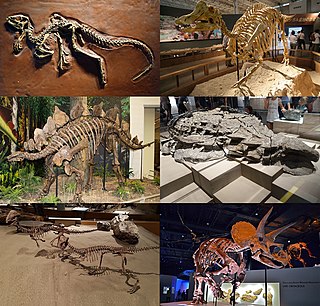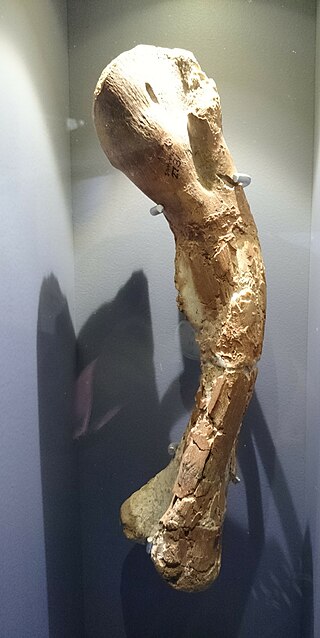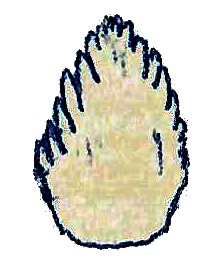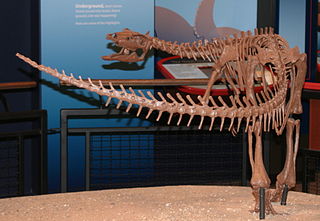
Ornithischia is an extinct clade of mainly herbivorous dinosaurs characterized by a pelvic structure superficially similar to that of birds. The name Ornithischia, or "bird-hipped", reflects this similarity and is derived from the Greek stem ornith- (ὀρνιθ-), meaning "bird", and ischion (ἴσχιον), meaning "hip". However, birds are only distantly related to this group, as birds are theropod dinosaurs. Ornithischians with well known anatomical adaptations include the ceratopsians or "horn-faced" dinosaurs, the pachycephalosaurs or "thick-headed" dinosaurs, the armored dinosaurs (Thyreophora) such as stegosaurs and ankylosaurs, and the ornithopods. There is strong evidence that certain groups of ornithischians lived in herds, often segregated by age group, with juveniles forming their own flocks separate from adults. Some were at least partially covered in filamentous pelts, and there is much debate over whether these filaments found in specimens of Tianyulong, Psittacosaurus, and Kulindadromeus may have been primitive feathers.

Kangnasaurus is a genus of iguanodontian ornithopod dinosaur found in supposedly Early Cretaceous rocks of South Africa. It is known from a tooth and possibly some postcranial remains found in the early-Aptian Kalahari Deposits Formation. It was probably similar to Dryosaurus.

Phyllodon was a genus of small ornithischian dinosaur from the Kimmeridgian-aged Upper Jurassic Camadas de Guimarota Formation of Leiria, Portugal and possibly also the Bathonian-aged Chipping Norton Limestone of England. It may have been closely related to contemporaneous dinosaurs in North America.
Gongbusaurus is a genus of ornithischian, perhaps ornithopod, dinosaur that lived between about 160 and 157 million years ago, in the Late Jurassic period. A small herbivore, it is very poorly known. Two species have been assigned to it, but as the original name is based on teeth, there is no concrete evidence to connect the two species. Its fossils have been found in China.

Cedrorestes is a genus of iguanodontian dinosaur from the Early Cretaceous of Utah. It is based on an incomplete skeleton which was found in the Valanginian-age Yellow Cat Member of the Cedar Mountain Formation.

Dryosauridae was a family of primitive iguanodonts, first proposed by Milner & Norman in 1984. They are known from Middle Jurassic to Early Cretaceous rocks of Africa, Europe, and North America.

Halszka Osmólska was a Polish paleontologist who had specialized in Mongolian dinosaurs.
Teresa Maryańska was a Polish paleontologist who specialized in Mongolian dinosaurs, particularly pachycephalosaurians and ankylosaurians. Peter Dodson states that in 1974 Maryanska together with Halszka Osmólska were among the first "women to describe new kinds of dinosaurs". She is considered not only as one of Poland's but also one of the world's leading experts on dinosaurs.
The Twin Mountains Formation, also known as the Twin Mak Formation, is a sedimentary rock formation, within the Trinity Group, found in Texas of the United States of America. It is a terrestrial formation of Aptian age, and is notable for its dinosaur fossils. Dinosaurs from this formation include the large theropod Acrocanthosaurus, the sauropod Sauroposeidon, as well as the ornithopods Tenontosaurus and Convolosaurus. It is the lowermost unit of the lower Cretaceous, lying unconformably on Carboniferous strata. It is overlain by the Glen Rose Formation. It is the lateral equivalent of the lower part of the Antlers Formation.
The El Castellar Formation is a geological formation in La Rioja and Teruel, Spain whose strata date back to the possibly the Valanginian to the Barremian stages of the Early Cretaceous. Dinosaur remains are among the fossils that have been recovered from the formation.
The Trichinopoly Group is a geological formation in India whose strata date back to the Late Cretaceous. It lies between the Ootatoor and Ariyalur Groups. It is broad in its southern extremity but thins as it gradually proceeds northwards as it ultimately meets the Ariyalur Group. Dinosaur remains are among the fossils that have been recovered from the formation.

Thescelosauridae is a clade of neornithischians from the Cretaceous of East Asia and North America. The group was originally used as a name by Charles M. Sternberg in 1937, but was not formally defined until 2013, where it was used by Brown and colleagues as the group uniting Thescelosaurus and Orodromeus, based on their phylogenetic results. During a phylogenetic revision of neornithischians by Clint Boyd in 2015, the authorship of Thescelosauridae was given to Brown and colleagues, which meant that the similar name Parksosauridae, informally defined in 2002 by Buchholz, would have had priority over Thescelosauridae. The two clades had slightly different definitions, with Parksosauridae referring to all animals closer to Parksosaurus than Hypsilophodon, but they contained the same taxa so Boyd used Parksosauridae under the assumption it had priority. However, in formalizing the clade following the regulations of the PhyloCode, Madzia, Boyd, and colleagues identified in 2021 that Sternberg was the proper authority for Thescelosauridae, giving it priority over Parksosauridae. As well, they gave Thescelosauridae the definition of the largest clade containing Thescelosaurus neglectus but not Iguanodon bernissartensis, as long as Hypsilophodon foxii was not in the group, modifying previous definitions for Thescelosauridae in order to maintain its modern use, so that the clade was not applied if Thescelosaurus fell within Hypsilophodontidae, a family that has not been recently used but may be revived if the systematic position of Hypsilophodon was solidified at some point in the future. Madzia et al. identified the analysis of Madzia et al. in 2018 as the reference analysis for the name Thescelosauridae, an analysis based on a revised version of the 2015 Boyd analysis.

The Dinosauria is an extensive book on dinosaurs, compiled by David B. Weishampel, Peter Dodson, and Halszka Osmólska. It has been published in 2 editions, with the first edition published in 1990, consisting of material from 23 scientists. The second, greatly revised edition, was published in 2004, with material from 43 scientists. Both editions were published by University of California Press.
The Wagad Formation is a Mesozoic Late Jurassic geologic formation in India. Fossilised sauropod and ornithopod tracks have been reported from the formation.
The Kagidani Formation is a Mesozoic geologic formation in Japan. Fossil ornithopod tracks have been reported from the formation.
The Nanchao Formation is a Late Cretaceous geologic formation in China. Fossil ornithopod tracks have been reported from the formation. Embryos of therizinosaurs are known from the formation
The Nagatogawa Formation is a Mesozoic geologic formation in Japan. Fossil ornithopod tracks have been reported from the formation.
The Chiating Series is a Mesozoic geologic formation in China. Fossil ornithopod tracks have been reported from the formation.
The Tongfosi Formation is a Late Cretaceous (Cenomanian) geologic formation of the Yanji Group in China. Fossil ornithopod tracks of iguanodontids and theropods have been reported from the fluvial sandstones of the formation.
The Tochikubo Formation is a Jurassic geologic formation in northern Honshu, Japan, dating to the Oxfordian stage of the Late Jurassic. Fossil ornithopod tracks have been reported from the formation. As well as the Bennettitalean Kimuriella.









